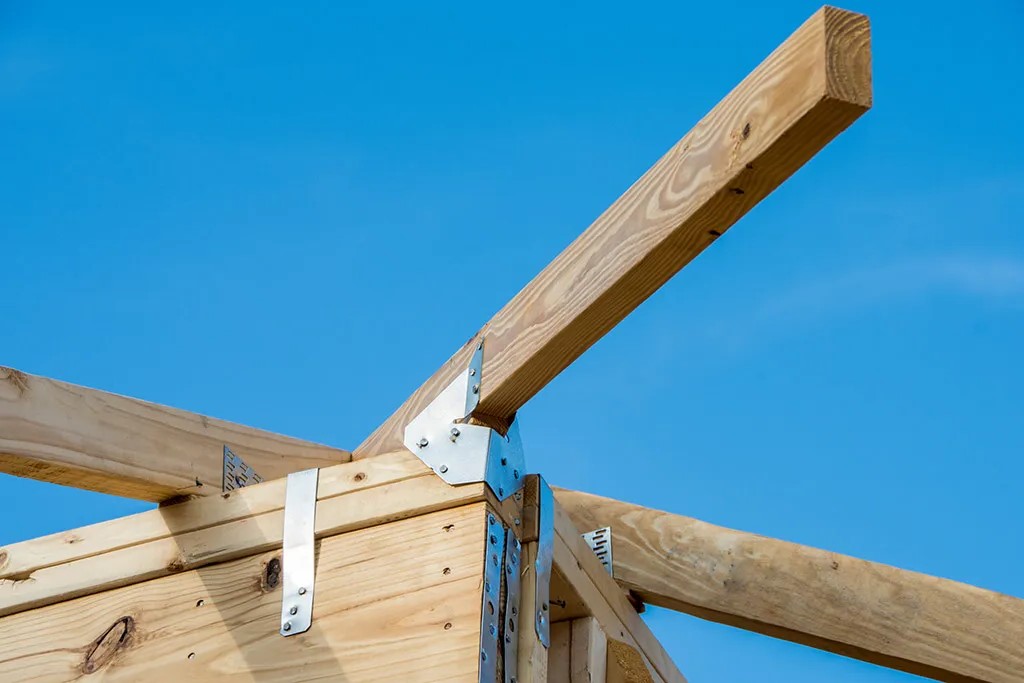- Discover how Hurricane Straps create a continuous load path for wind resistance.
- Learn about the different types of Hurricane Ties and Hurricane Clips.
- Understand how Construction Ties improve the safety and value of your home.
In hurricane-prone areas, safeguarding your home against high winds and severe weather conditions is essential. Hurricane Straps, often referred to as Hurricane Clips or Hurricane Ties, play a pivotal role in protecting homes from storm damage. These specialized metal connectors ensure a stronger connection between a building’s roof trusses and its walls, helping to prevent catastrophic structural failures during hurricanes. Understanding their purpose, installation, and benefits can help homeowners make informed decisions about improving their home’s resilience.
What Are Hurricane Straps?
Hurricane Straps are metal connectors designed to strengthen the attachment points between a building’s roof and walls. They are typically crafted from galvanized steel or stainless steel, materials known for their corrosion resistance, which ensures longevity even in humid or coastal climates. These straps, along with Hurricane Clips and Hurricane Ties, are engineered to withstand the powerful forces exerted by high winds, including uplift and lateral pressure.
When installed correctly, Hurricane Straps distribute these forces across the building, reducing the likelihood of the roof being lifted off or walls collapsing under wind pressure.
The Purpose of Hurricane Straps
The main goal of Hurricane Straps is to create a “continuous load path,” a term used in construction to describe how forces are transferred through the structure from the roof down to the foundation. This path helps spread the load evenly and prevents weak points that high winds could exploit.
Without Hurricane Straps, the connection between roof trusses and walls may not be strong enough to handle the intense uplift and suction forces created during a hurricane. By securely tying the roof to the building, these straps ensure the integrity of the entire structure, protecting occupants and reducing property damage.
Types of Hurricane Straps and Ties
There are several types of Hurricane Straps, each suited for different construction needs. Understanding their variations can help builders and homeowners choose the right solution:
- Single Wrap Straps
- These straps wrap over the top of the roof trusses or rafters and are nailed into both sides of the wall plate. Their design offers robust wind resistance.
- Double Wrap Straps
- These function similarly to single wrap straps but provide extra reinforcement by using two layers. They are commonly used in areas with stricter building codes or higher wind risks.
- Hurricane Clips
- These smaller connectors attach the roof trusses or rafters directly to the top plate of the wall. Hurricane Clips are ideal for homes where a simpler installation process is preferred, but their effectiveness depends on precise placement.
- Construction Ties
- These connectors can serve multiple purposes in a structure, offering versatility and additional support for roofs and walls.
How Are Hurricane Straps Installed?
Proper installation is critical to the effectiveness of Hurricane Straps. Each strap or clip must be placed where roof trusses or rafters meet the wall plate. Installers use heavy-duty nails or screws as specified by the manufacturer to ensure a secure hold.
Here are a few key steps:
- Placement: Position the strap over the connection point between the roof and wall. For Hurricane Clips, ensure they are aligned precisely to maximize strength.
- Fastening: Secure each strap with the recommended fasteners, ensuring they are driven fully into both the trusses and wall plates.
- Spacing: Straps should be installed at every truss or rafter to create a continuous load path.
Professional contractors follow local building codes and manufacturer guidelines to guarantee the installation meets safety standards.
Why Building Codes Require Hurricane Straps
In many states, especially those along the Gulf Coast and Eastern Seaboard, building codes mandate the use of Hurricane Straps for new constructions or substantial renovations. These requirements reflect the straps’ effectiveness in protecting homes from storm damage.
Compliance with these regulations:
- Improves safety for occupants.
- Reduces potential repair costs after hurricanes.
- May lower homeowners’ insurance premiums.
Failing to meet code requirements can result in fines and leave homes vulnerable to preventable damage during a storm.
Benefits of Hurricane Straps
Investing in Hurricane Straps, Hurricane Clips, or Hurricane Ties provides multiple advantages for homeowners:
- Enhanced Stability: Strengthening the roof-wall connection minimizes the risk of structural failure during storms.
- Long-Term Savings: By protecting the structure, straps help homeowners avoid costly repairs or complete roof replacements after hurricanes.
- Increased Safety: Securing the roof reduces the risk of debris falling onto occupants, safeguarding lives.
- Improved Property Value: Homes with reinforced construction are more attractive to buyers in hurricane-prone areas.
Hurricane Straps and Retrofitting
For homes built before modern building codes required Hurricane Straps, retrofitting is an option. This process involves adding straps or Construction Ties to strengthen existing connections. While retrofitting may require more effort than installing straps during initial construction, it significantly increases a home’s resilience against hurricanes.
Hurricane Straps are an essential component in protecting homes from the devastating effects of hurricanes. By securely tying the roof to the walls, these connectors maintain the structural integrity of the building, preventing catastrophic failures caused by high winds. For homeowners in hurricane-prone areas, installing Hurricane Straps, Hurricane Clips, or Hurricane Ties is a proactive step toward safety and peace of mind.
Whether you’re building a new home or retrofitting an older structure, ensuring your home is equipped with proper wind-resistant connections is a smart and effective investment.
If you’re ready to enhance your home’s hurricane resilience, contact Jack C. Wilson Roofing Co. for professional advice and installation.


